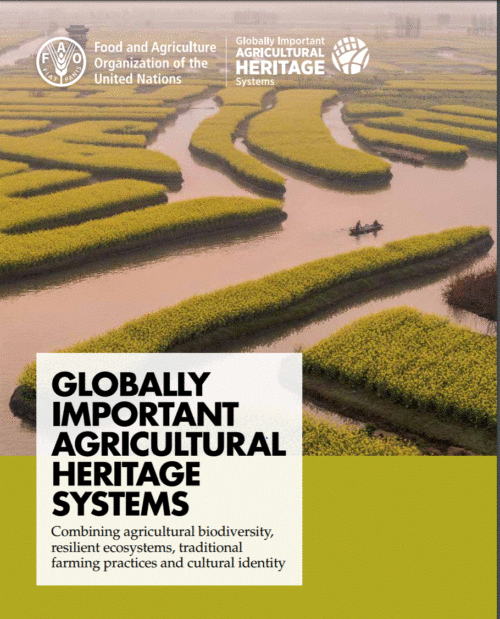
Globally Important Agricultural Heritage Systems(GIAHS) are outstanding landscapes of aesthetic beauty that combine agricultural biodiversity, resilient ecosystems and a valuable cultural heritage.Located in specific sites around the world, they sustainably provide multiple goods and services, food and livelihood security for millions of small-scale farmers.
Why is there a Need for GIAHS?
1.These agricultural systems are threatened by many factors including climate change and increased competition for natural resources.
2.They are also dealing with migration due to low economic viability, which has resulted in traditional farming practices being abandoned
3. Endemic species and breeds being lost.
4.These ancestral agricultural systems constitute the foundation for contemporary and future agricultural innovations and technologies. Their cultural, ecological and agricultural diversity is still evident in many parts of the world, maintained as unique systems of agriculture.
- Number of sites in the world- 57 sites in 21 countries
- Number of sites in India– 3
GIAHS List in India
1.Saffron Heritage of India
Site location: Pampore Karewas, Kashmir, Northern India
Climatic Classification: tropical conditions
- Saffron is mentioned in the 5th century B.C in Kashmiri records and is still part of the agricultural economy. Integrated an annual crop system, Saffron is also a cash crop. With respect to occupation, only 1 per cent of saffron growers are dependent on any other agriculture.
Saffron is part of the cultural heritage of the Region, associated with the famous Kashmiri cuisine, its medicinal values and the rich cultural heritage of Kashmir. Looking at the social organization, Kashmiri women are behind the whole saffron story being the custodian of the knowledge.
- Threats-
-severe challenges of sustainability and livelihood security
-water scarcity
-productivity loss market volatilities.
2.Koraput Traditional Agriculture
Site location: KORAPUT Region, ORISSA STATE, INDIA
Climatic Classification: tropical conditions
Ethnic Groups/Indigenous People: 52 tribal groups mainly Khond, Bhatada, Paroja, Bhumia, Bondas, etc
- Being sustainable and integrated to its environment, the traditional farming systems of the local communities plays a role in conserving the rich floristic diversity consisting of about 2500 species of flowering plants. Strongly linked as a cultural trait, sacred grove is an effective method of preserving plant genetic resources. It is a biological heritage as well as social mechanism by which a forest patch is protected with a religious significance.From their knowledge and practices, a high biodiversity has been conserved through an in-situ conservation preserving endemic species.
- Threats-
-Mining
-Deforestation
3.Kuttanad Below Sea Level Farming System
Site location: Kuttanad region, Kerala State, INDIA
Topological Characteristics: wet lands
Climatic Classification: humid tropical conditions
- Kuttanad Wetland Agriculture System is unique, as it is the only system in India that favours rice cultivation below sea level in the land created by draining delta swamps in brackish waters.
The Kuttanad system is a complex mosaic of fragmented agricultural landscapes divided in three structures:
a) wetlands used for paddy activities and fish catching,
b) garden lands used for coconut, tubers and food crops plantation and
c) water areas used as inland fishing and shells. Wetlands are created thanks to the construction of polders with bunds and its dewatering.
- Threats
– Use of chemicals
– Severe pollution of waters due to tourism
Though Not a GIAHS, you should know that traditional rice cultivation is practised by Apatani tribes in Ziro Valley of Arunachal Pradesh.
(Apatani tribes has been asked in UPSC prelims in the past)
